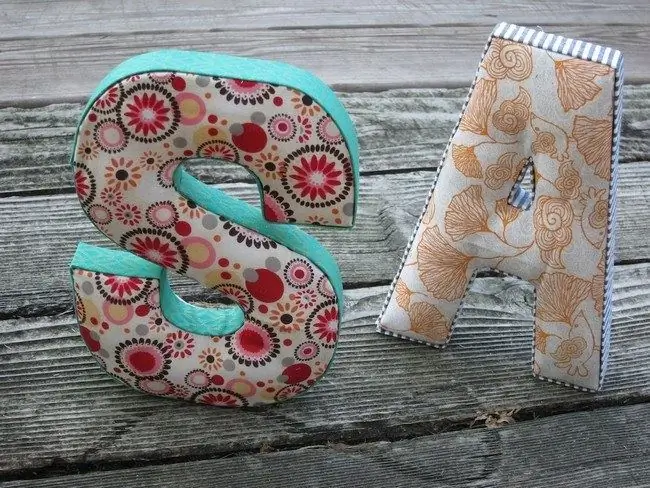Soft, pleasant to the touch, volumetric letters made of bright fabrics are not only an excellent educational material for a child, but also a nice element of interior decor. To make textile letters, you will need a non-flowing fabric, a stencil and a little sewing skills on a typewriter.

Sewing by hand
The easiest way to make homemade cloth letters does not involve using a sewing machine. The silhouette of the necessary letters is printed on a printer or drawn by hand and the pattern is transferred to a dense fabric, convenient for needlework: fleece, felt, drape, etc.
Two parts are cut out of the fabric, folded with the wrong sides inward and sewn with an overcast or any other beautiful hand-stitched seam. As the elements of the letter are sewn together, the finished product is stuffed with a soft filler: padding polyester, holofiber, pieces of foam rubber. The finished letter is decorated with bright buttons, ribbons and other decorative elements.
Curly edge letters
Sewing letters from fabric using curly scissors is suitable for novice needlewomen who have no experience with complex set-in elements. To make such letters, you will need paper or cardboard templates, fabric with non-crumbling edges and special scissors, the blades of which are made in the form of teeth or waves.
The two parts cut out of the fabric are folded with the wrong sides inward, a thick layer of padding polyester is laid between the parts and, retreating from the edge about 1 cm, the outline of the letter is sewn. After that, the indentation of the edge of the product is cut off with curly scissors.
Three-dimensional letter
More painstaking is the production of volumetric three-dimensional letters with the seams removed inside. To sew such products, you will need paper stencils, with the help of which not only the main contours of the letter are cut out of a suitable fabric, but also strips of the side, bottom and inner sides, giving the product volume.
Textile letters look very attractive, in which the inner sides are made of fabric of a contrasting color or other texture. To give the product additional rigidity, it is recommended to seal the material with a layer of adhesive strip: non-woven or doublerin.
Parts are cut taking into account seam allowances of 0, 6-0, 8 mm. After that, one main part of the letter is folded with its sides with the front sides inward and neatly stitched with a straight machine stitch. Small notches should be made on the bends and corners of the letters so that the fabric does not gather in small folds.
If the letter to be produced has internal holes, as in the letters "A", "B", "P", etc., it is necessary to measure them and sew a cylindrical piece from a small piece of cloth of the appropriate size and sew it with the front side to the outside of the hole.
After that, the second main part is sewn to the workpiece and through the inner hole or the seam not sewn to the end, the whole letter is turned out onto the front side. The finished product is stuffed with padding polyester, the remaining hole for the filler is manually sewn up and the letter is steamed, giving it a finished look.






